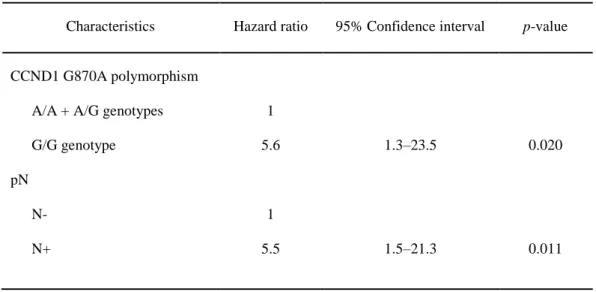HAL Id: inserm-00150983
https://www.hal.inserm.fr/inserm-00150983
Submitted on 4 Jun 2007
HAL is a multi-disciplinary open access
archive for the deposit and dissemination of
sci-entific research documents, whether they are
pub-lished or not. The documents may come from
teaching and research institutions in France or
abroad, or from public or private research centers.
L’archive ouverte pluridisciplinaire HAL, est
destinée au dépôt et à la diffusion de documents
scientifiques de niveau recherche, publiés ou non,
émanant des établissements d’enseignement et de
recherche français ou étrangers, des laboratoires
publics ou privés.
to neoadjuvant radiotherapy and prognosis in rectal
cancer.
Alexandre Ho-Pun-Cheung, Eric Assénat, Simon Thezenas, Frédéric Bibeau,
Rouanet Philippe, David Azria, Dominic Cellier, Jean Grenier, Marc Ychou,
Pierre Senesse, et al.
To cite this version:
Alexandre Ho-Pun-Cheung, Eric Assénat, Simon Thezenas, Frédéric Bibeau, Rouanet Philippe, et al..
Cyclin D1 gene G870A polymorphism predicts response to neoadjuvant radiotherapy and prognosis
in rectal cancer.. International Journal of Radiation Oncology - Biology - Physics, Elsevier, 2007, 68
(4), pp.1094-101. �10.1016/j.ijrobp.2007.01.022�. �inserm-00150983�
Table 1. Characteristics of the patients
Parameter Number of patients (%)
Total patients 70 (100) Gender Male 44 (62.9) Female 26 (37.1) Tumor grade Well differentiated 36 (51.4) Moderately differentiated 28 (40.0) Poorly differentiated 6 (8.6) Pretherapeutic UICC TNM stage
Stage I 11 (15.7) Stage II 22 (31.4) Stage III 25 (35.7) Stage IV 12 (17.2) Radiotherapy (Gy) 45 41 (59.0) 60 29 (41.0) TRG(grouped)
Nonresponder group (TRG 0 and 1) 30 (42.9) Responder group (TRG 2, 3, and 4) 35 (50.0)
Non-evaluable* 5 (7.1) pT T0 4 (5.7) T1 6 (8.5) T2 26 (37.1) T3 34 (48.7) pN
N- 48 (68.6) N+ 22 (31.4) Local Recurrence L- 62 (88.6) L+ 8 (11.4) Distant Recurrence† D- 46 (79.3) D+ 12 (20.7)
Abbreviations: UICC = International Union Against Cancer; TRG = tumor regression grade; pT and pN =
pathologic tumor stages.
*The number of available tumor paraffin-embedded sections was not sufficient for TRG evaluation.
Table 2. Association between patient characteristics and response to radiotherapy Characteristics Major response n (%) Poor response n (%) p-value Gender NS Male 24 (57.1) 18 (42.9) Female 11 (47.8) 12 (52.2) Age NS ≥ 65 18 (52.9) 16 (47.1) < 65 17 (54.8) 14 (45.2) Tumor grade NS Well differentiated 19 (55.9) 15 (44.1) Moderately differentiated 11 (44.0) 14 (56.0) Poorly differentiated 5 (83.3) 1 (16.7)
Pretherapeutic UICC TNM stage NS
Stage I 7 (63.6) 4 (36.4) Stage II 7 (35.0) 13 (65.0) Stage III 13 (59.1) 9 (40.9) Stage IV 8 (66.7) 4 (33.3) Synchronous metastases NS S+ 8 (66.7) 4 (33.3) S– 27 (50.9) 26 (49.1) Radiotherapy (Gy) NS 45 19 (50.0) 19 (50.0) 60 16 (59.3) 11 (40.7) CCND1 G870A polymorphism 0.022 A/A genotype 9 (90) 1 (10) A/G genotype 17 (42.5) 23 (57.5) G/G genotype 9 (60.0) 6 (40.0)
Table 3. Multivariate analysis of risk factors related to local recurrence
Characteristics Hazard ratio 95% Confidence interval p-value
CCND1 G870A polymorphism
A/A + A/G genotypes 1
G/G genotype 5.6 1.3–23.5 0.020
pN
N- 1


